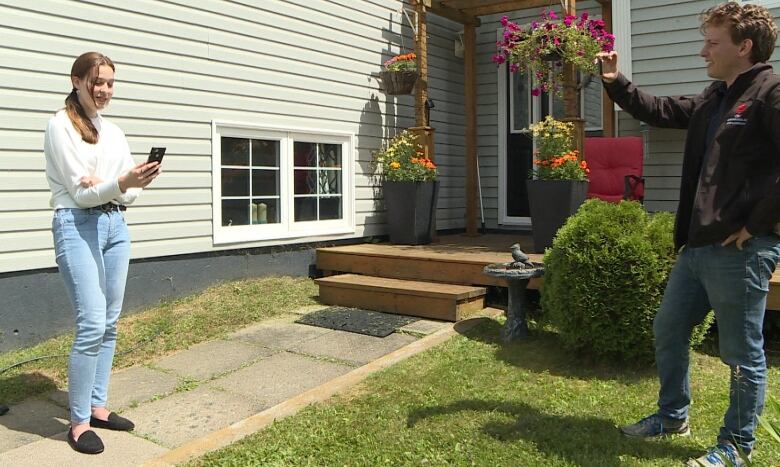Increased online learning puts rural N.L. schoolchildren at 'a huge disadvantage,' say families
Less than half of province's rural communities have internet speeds that match CRTC goals

The prospect of online learning this fall has become a frightening one for some families in rural Newfoundland and Labrador, who say their home internet services just don't have the bandwidth to shoulder the burden.
In St. Alban's which has seen government investment in internet services usersstruggle to stay connected, especially when another family member logs on.
"If we have to go down the road of distance education for the future, for the next year or so, we are at a huge disadvantage," said St. Alban'sMayor Gail Hoskins, who has one child in grade school and another enteringuniversity.
"I'm just praying every day that the school will be fully opened and all of our children will be back in school."
Hundreds of kilometres away on the Bonavista Peninsula, video calls are only a dream for some residents even asvideo conferencing has taken the world by storm during the COVID-19 pandemic, and been heavily used to connect students and teachers.
"If [my child is]only able to hear 30 per cent of what someone is saying, how is he supposed to get a full education?" asked Leah Hollahan, a parent of two in Southern Bay, on the western side of the peninsula.
"If you don't show up to school, you don't learn, and it's going to be the equivalent of not showing up."
The provincial government's back-to-school plan aims to have all students back in class for September. But that option depends entirely on the containment of COVID-19, and the Department of Education has prepared two other backup scenarios, where classes are either partially or completely delivered at home.

Having both her kids at home, vying for screen time, isless than ideal for Hoskins' family.
"It's not going to be a very nice situation at my home because we're all going to be fighting over the internet," she said.
Spotty connections
Students in rural Newfoundland and Labrador already got a taste of online education in late winter, when COVID-19 closed schools in March and some coursework went virtual.
LaciOrgan of St. Alban's, who is heading into Grade 12, said as thatwas optional learning, some childrendidn't bother but she wanted to keep up with her advanced math class work.
Or at least, she tried to.
"If I'm doing it at home, like sat in my basement, then the audio feed will stop, and it will kind of delay for a second, and then after 10 seconds or so, it picks up but the audio is just completely sped up," she said.
"So it's like the teacher is talking a mile a minute."
And it's not just students having trouble.
"The teacher would record one class. She would record herself teaching the class and then she would post it online, and it would take about five hours to post a 15-minute video," Organ said.

Her boyfriend, Nathan Manuel, lives on the other side of Bay d'Espoir in Milltown. He's preparing for his first year of online university instruction, but expects serious lags thanks to younger siblings competing for his bandwidth.
"Both of my siblings are in primary and junior high, sowith them accessing the internet at the same time, it's going to be a lot of traffic," he said, adding he has no confidence the internet can keep up.
"We can't have more than fouror fivepeople on the Wi-Fiat once, or else it completely falls apart."
- What are the internet speeds near you? Check theNational Broadband Internet Service Availability Map
The CRTC has set a goal for every Canadian internet user to have access to a 50 megabit per seconddownload speed. As of 2018,less of half of rural households in Newfoundland and Labrador have that access.
What about all those investments?
In 2014, Newfoundland and Labrador's provincial government gave Bell Aliant more than $1 millionto upgrade broadband infrastructure on the Connaigre Peninsula where both Organ and Manuel live.
According to documents later released under the province's access to information act, the conditions of that deal required Bell Aliantto install DSL lines in the area, that could deliver internet speeds between 1.5 to five megabits per second.

That was a common target for the government's Rural Broadband Initiative deals, and the province made more than a dozen of them even if, by 2014, most households in the province could access speeds higher than 25 megabits per second.
Since 2014, however, data use across the country has exploded fuelled by the rise of high-definition video streaming and video-chatting software.
In 2018, according to the CRTC, the average Canadian high-speed internet user downloaded more than 200 gigabytes' worth of data, and the weighted average residential download speed was 126 megabits per second 25 times the speed that the provincial government shelled out for in 2014.
"That's like buying all the same-sized shoes for somebody going to school. You know, your shoe size don't last forever. You can't have those shoes last forever," saidHollahan, from her home in Southern Bay.

Hollahan said DSL service came to her community in 2012, and although she pays for seven megabits per second, she tends to get between one to three hardly enough to handle a video call, she said.
School vs. home connections
Despite these household challenges, distance and virtual education has been a staple of life in rural Newfoundland and Labrador for years.
However, that learninghastraditionally taken place in computer labs inside of schools, using the Newfoundland and Labrador English School District's Centre for Distance Learning and Innovation.
Organ said she's taken CDLI classes before, and the system has worked pretty well thanks tothe stable internet access available inside schools.
But when students left their buildings and headed home in March and teachers started using data-hogging tools like Google Hangoutsor Zoom things got harder.
"I got one of the better systems here, so I might be able to download.But like, for any video calls or anything like that, we wouldn't be able to do much with it," said Keith Ralph, a father totwo school-aged children in Winter Brook, on the Bonavista Peninsula.

The Newfoundland and Labrador English School District has signed on to Google's G Suite for Education, and said in a statement that those tools are recommended for teachers for virtual class delivery in the fall, if needed, because teachers and students are familiar.
That bundle of programs includes video-chatting software.
"Numerous approaches are being reviewed as the district plans for all three scenarios presented in government's guidance, including low-technology and low-data options for areas where connectivity to a stable network could pose a challenge," added Cheryl Gullage, a spokesperson for the school district, in an email to CBC News.
But it's not just school-sanctioned tools that matter, saidHollahan, pointing to a world of YouTube video tutorials and other online tools that her children don't have the same chance to access.
Long-term problem
The school district plans to hand out around 500 MiFi devicestostudents who have access to cellular signals strong enough to support mobile hotspots, but no device or account to access them.
That's in addition to the 200 devices that were distributed in March and April.
That won't work in Winter Brook, where cell service is just as bad ashomeinternet availability.
"I'm higher in elevation so I can get a littlebit of cell coverage," said Ralph. "Even if I get a cellphone call, usually I have to go outside and go to the corner of my driveway in order to take the call."
"I think everybody's on the same mindset as me. Everybody is concerned about it."

In a statement, a spokesperson for the Department of Education said connectivity is an issue that needs to be addressed by "provincial authorities, in partnership with their federal counterparts and Internet service providers."
Internet speed and availabilityis a long-term infrastructure issue, and one that will be difficult to meaningfully address in many communitiesbefore school starts in September.
But Hollohansaid the effects of falling behind in education are long-lasting, too.
"I'm probably going to have to get [my daughter] an apartment somewhere, just for the use of internet," Hollahan said.
"I really don't know how it's going to work."












_(720p).jpg)


 OFFICIAL HD MUSIC VIDEO.jpg)
.jpg)



























































































